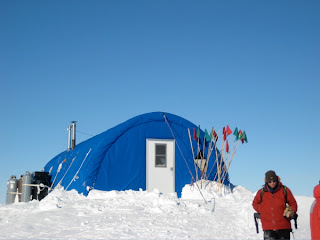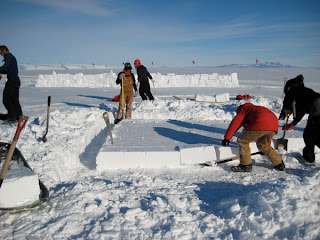I just returned from my Happy Camper School.
 I am happy because I lived to tell the story! It started off on Friday morning with the class, a group of 20 people with all different roles (carpenters, researchers, snowmobile mechanics, recreation coordinators, students) all talking and watching powerpoint presentations which focused mainly on the hazards of the cold climate here in Antarctica. We learned about what is in a Survival Bag, and how you must ALWAYS have one with you when you leave McMurdo. In Antarctica, conditions can change quite quickly and you never know when you will be stranded with no visibility and you need to set up a tent right where you are.
I am happy because I lived to tell the story! It started off on Friday morning with the class, a group of 20 people with all different roles (carpenters, researchers, snowmobile mechanics, recreation coordinators, students) all talking and watching powerpoint presentations which focused mainly on the hazards of the cold climate here in Antarctica. We learned about what is in a Survival Bag, and how you must ALWAYS have one with you when you leave McMurdo. In Antarctica, conditions can change quite quickly and you never know when you will be stranded with no visibility and you need to set up a tent right where you are.  So we learned about the contents of the survival bag, and we discussed the dangers of cold weather, including hypothermia and frostbite, and how to avoid them.
So we learned about the contents of the survival bag, and we discussed the dangers of cold weather, including hypothermia and frostbite, and how to avoid them. We then gathered materials and food, and headed out for a 40 minute drive or so, out past the New Zealand Base called Scott Base, to where Happy Camper School is located.
We then gathered materials and food, and headed out for a 40 minute drive or so, out past the New Zealand Base called Scott Base, to where Happy Camper School is located.  There is a teaching hut there with chairs gathered around a nice heater. Once there, we discussed more strategies for survival – like how to operate the little stoves in the Survival Bags, how to look for frostbite or frostnip on one another, and so forth.
There is a teaching hut there with chairs gathered around a nice heater. Once there, we discussed more strategies for survival – like how to operate the little stoves in the Survival Bags, how to look for frostbite or frostnip on one another, and so forth.Then it came time to SURVIVE the cold! We put on all of our Extreme Cold Weather Gear and went out into the field. It was a gorgeous day with the sun out and, thankfully, very calm. But it was still around minus 20 degrees!
 We learned how to put up Scott tents,
We learned how to put up Scott tents,  and secure them in the ground under the snow. We also learned how to put up Mountain Tents. Together, we built a snow dome called a Quinzie
and secure them in the ground under the snow. We also learned how to put up Mountain Tents. Together, we built a snow dome called a Quinzie , and we also built a number of trenches in the snow.
, and we also built a number of trenches in the snow.  Then, with an ice saw, we cut bricks of snow and made a beautiful wall to protect our camp from the wind.
Then, with an ice saw, we cut bricks of snow and made a beautiful wall to protect our camp from the wind. 
All of this exertion made us quite hot, and we had to take off layers to keep from sweating too much. But as soon as we stopped exerting, we had to pile layers back on to keep ourselves warm! It was a constant struggle to bare our fingers enough for dexterity to tie knots, fill stoves with gas, and zip zippers – but to protect our hands from the biting cold at the same time. Likewise, sunglasses, desperately needed for protection from the strong sun and reflection off of the bright snow surface, fogged up instantly. So we needed to wear goggles to protect our eyes and prevent fogging.
We worked on our camp until about 7:00, and then we started to set up stoves, melt water for cooking and for drinking.



As the sun got lower and lower in the sky, the temperature got colder and colder.
 We ran around a great deal, did jumping jacks, or just simply dug holes to try to stay warm. Eventually though, with the sun still relatively high in the sky, everyone chose a place to sleep and grabbed a sleeping kit to go to bed.
We ran around a great deal, did jumping jacks, or just simply dug holes to try to stay warm. Eventually though, with the sun still relatively high in the sky, everyone chose a place to sleep and grabbed a sleeping kit to go to bed.  We had packed up the sleeping kits, which included a sleeping bag, 2 foam pads, and a fleece sleeping bag liner. I chose to set up my bed in one of the Scott Tents with two others.
We had packed up the sleeping kits, which included a sleeping bag, 2 foam pads, and a fleece sleeping bag liner. I chose to set up my bed in one of the Scott Tents with two others.To my dismay, I discovered that my sleeping bag zipper was broken. As soon as I crawled into my bag, the zipper split and would not close again. I struggled all night to stay warm, trying every sleeping position I could to be on top of the broken zipper to stop the cold, cold air from flowing in. But I was not very successful. It was just a long, long night – no way around that! I ate frozen raisins, chocolate, and nuts all night to try to help my body fight the cold. We had a 5 gallon jug of water that we took into the tent, and it was frozen solid within a very short time.
But... I learned a tremendous amount about how to survive. I also saw how incredibly important it is to operate as a team, and to watch outfor one another.
When we got up in the morning, we cooked breakfast and took down allof our shelters. Exhausted, we put all of the gear away - and spentthe rest of the day discussing what worked and didn't work, and working through some realistic scenarios of survival. One scenario was that we were out in the field with one other person, a storm kicked up, and we were stranded. We had nothing but our survival bag and a radio. We had half an hour to get up our survival camp and contact either the South Pole or McMurdo Station by radio. Working together, we did it! The other scenario was that one of our teammates got lost in whiteout conditions and we had to rescue that person. We figured out that the best way to look for that person, who may be unconscious, was to have one person tethered to a building, and the rest of us to spread out on a rope - with buckets over our heads to simulate whiteout - to locate our lost teammate.
 Good training, as these scenarios are very realistic!
Good training, as these scenarios are very realistic!So I was thrilled to experience Happy Camper School, and delighted to come home to a warm bed when it was all over.
My departure for the deep field has been delayed - and we do not know when we will be taking off. A reconnaissance helicopter survey of the route out to the field location has shown some big cracks in the sea ice. So we will need to do some further investigating before taking off for the field.
On the bright side, the ANDRILL drill rig will likely pull out its first sample from the seafloor tonight. So the work on the core is about to begin. Stay tuned for news on that!!! And please check out the blogs from my fellow ARISE teammates who will be working directly on the core when it is retrieved.l


No comments:
Post a Comment